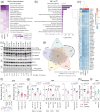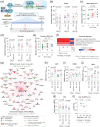Epigenetic modulators link mitochondrial redox homeostasis to cardiac function in a sex-dependent manner
- PMID: 38509128
- PMCID: PMC10954618
- DOI: 10.1038/s41467-024-46384-8
Epigenetic modulators link mitochondrial redox homeostasis to cardiac function in a sex-dependent manner
Abstract
While excessive production of reactive oxygen species (ROS) is a characteristic hallmark of numerous diseases, clinical approaches that ameliorate oxidative stress have been unsuccessful. Here, utilizing multi-omics, we demonstrate that in cardiomyocytes, mitochondrial isocitrate dehydrogenase (IDH2) constitutes a major antioxidative defense mechanism. Paradoxically reduced expression of IDH2 associated with ventricular eccentric hypertrophy is counterbalanced by an increase in the enzyme activity. We unveil redox-dependent sex dimorphism, and extensive mutual regulation of the antioxidative activities of IDH2 and NRF2 by a feedforward network that involves 2-oxoglutarate and L-2-hydroxyglutarate and mediated in part through unconventional hydroxy-methylation of cytosine residues present in introns. Consequently, conditional targeting of ROS in a murine model of heart failure improves cardiac function in sex- and phenotype-dependent manners. Together, these insights may explain why previous attempts to treat heart failure with antioxidants have been unsuccessful and open new approaches to personalizing and, thereby, improving such treatment.
© 2024. The Author(s).
Conflict of interest statement
F.K., J.L., A.W., R.J., R.B., T.J., E.F., M.F., A.D., Cl.B. and R.M. are current employees or were employees of AstraZeneca and may own stock or stock options. The rest of the authors declare no competing interests.
Figures







References
MeSH terms
Substances
LinkOut - more resources
Full Text Sources
Medical
Miscellaneous

